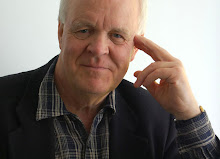The Illustrated Gormenghast and Titus Awakes
 Vintage will be publishing both The Illustrated Gormenghast and Titus Awakes, my mother's conclusion to the Titus Trilogy on 7th July. In a visual tour de force, the illustrated book will display over a hundred for the most part previously-unseen margin illustrations from the manuscript, while the latter book will be quite a revelation.
Vintage will be publishing both The Illustrated Gormenghast and Titus Awakes, my mother's conclusion to the Titus Trilogy on 7th July. In a visual tour de force, the illustrated book will display over a hundred for the most part previously-unseen margin illustrations from the manuscript, while the latter book will be quite a revelation.


2 Comments:
It's time for me to re-read my favourite books and discover something new then. Do you have publication dates?
The bizarre writing of Mervyn Peake. The savage and the dark. A staggering profusion of sensations and scents. And a massive dead castle in which to house them all.
The black, excrescent growth of Gormenghast.
It’s about time we had a new version of these twisted, beautiful books. A hardcover set, something of rare quality. I’m glad it’s finally here.
I didn’t know (until very recently) that it was the Centenary of Mervyn Peake’s birth. Interesting. In Canada, where I live now, no one ever talks about such things. It isn’t in any of the news. It might as well not exist at all.
I feel privileged simply to know that these books were written in the first place.
Mervyn Peake’s work changed my life. His sentences are what inspired me to become a writer. The cold, icy precison of his words. The almost mathematical focus on the bent and the extreme. I have never seen any other writing quite like it. A language that is still English, but not English as most people speak it. A dialect of the purest genius.
And it never gets old.
Most critics are baffled by Mervyn Peake. It is often said that no one knows where he obtained his twisted method of writing - his “Vast Alchemy,” as he called it. But I believe I have partially solved the mystery. This is only a theory of mine. But I think it’s a fruitful one. I wouldn’t mention it, normally, but this is Peake’s Centenary. I might as well give away one of my ideas.
I believe that Mervyn Peake developed his unusual way of writing from reading the work of Charles Dickens. Dickens’ style and Peake’s style are uncannily similar. Mervyn Peake’s sentences, of course, are more precise, more exotic, more technically advanced than Dickens’. They qualify as a different style. But the rhythm, the pulse, the bounce of the words are EXACTLY the same. An internal rhythm that is not poetry, but is recognizable like a fingerprint. It’s unmistakable.
I always look for this particular rhythm when reading the works of others, but have never found it up till now.
I recognized it instantly in Dickens.
It’s amazing what is hidden from us in this world. And it’s intriguing when such things are finally uncovered.
Post a Comment
Subscribe to Post Comments [Atom]
<< Home